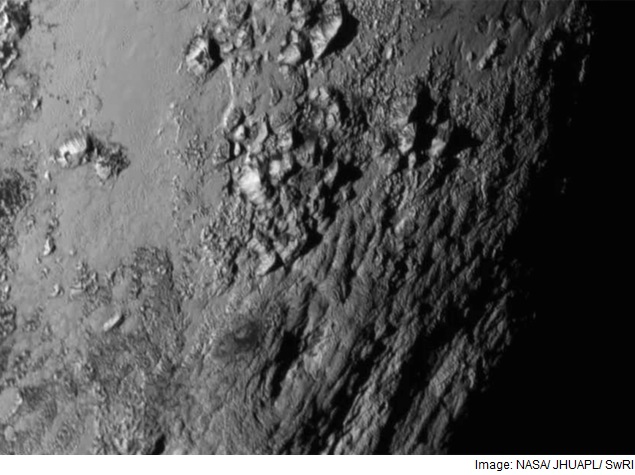- Home
- Science
- Science News
- Pluto Flyby Images Released by Nasa, Reveal Icy Mountain Ranges
Pluto Flyby Images Released by Nasa, Reveal Icy Mountain Ranges

The mountains' elevation reaches 11,000 feet (3,400 metres), the US space agency said, or about as high as the Rocky Mountains.
Scientists were also stunned to see a close-up section of Pluto that showed no sign of craters, despite its home in the Kuiper Belt, the region beyond Neptune where cosmic debris is constantly pelting Pluto and its five moons.
Nasa said the findings suggest that Pluto is geologically active, and contains parts that are youthful in astronomical terms, perhaps less than 100 million years old, a small fraction of the 4.5 billion year age of the solar system.
"It might be active right now," said project scientist John Spencer.
Scientists first saw hints of a geologically active phenomenon on Triton, a moon of Neptune that was glimpsed by the Voyager 2 space mission in the 1980s. It also had virtually no impact craters.
"Now we have settled the fact that these very small planets can be very active after a long time and I think it is going to send a lot of geophysicists back to the drawing boards to try and understand how exactly you do that," said principal investigator Alan Stern.
"The bedrock that makes those mountains must be made of H20, of water-ice," said Stern.
Other kinds of ice that are abundant on the surface of Pluto are made of nitrogen, methane and carbon monoxide.
"You can't make mountains out of that stuff. It is just too soft," Spencer told reporters.
Historic flyby
New Horizons, a $700 million (roughly Rs. 4,445 crores) nuclear-powered spacecraft, spent much of Tuesday snapping pictures and collecting data as it zoomed by Pluto.
The piano-sized spacecraft passed 7,750 miles or about the distance from New York to Mumbai, India from Pluto's surface.
Those images, including colour data on Pluto and some of its five moons, offer 10 times more detail than ever before seen.
But the information the spacecraft has gathered is only beginning to reach Earth, after a journey of nearly 10 years and three billion miles (4.8 billion kilometres).
And the data is going to keep coming in for the next 16 months, according to Stern.
Other images released Wednesday showed Charon, the largest moon of Pluto measuring about the size of Texas as having its own belt of troughs and cliffs that extend about 600 miles (960 kilometres) across the surface, as well as a canyon that is four to six miles deep.
"Charon just blew our socks off when we had the new image today," said deputy project scientist Cathy Olkin.
"It is a small world with deep canyons, roughs, cliffs, dark regions that are still slightly mysterious to us," she added.
"There is so much interesting science in this image alone."
Not since Nasa's Voyager 2 mission, which flew by Neptune in 1989, has a spacecraft visited a planetary system.
And Pluto, long considered the farthest planet from the Sun before it was reclassified as a dwarf planet in 2006, has never before been explored.
So far, a series of pictures from the spacecraft have revealed curious surface features, from a dark shadowy whale figure to a bright heart shape.
But just what these shapes are, or what kind of terrain they represent, remains unclear.
The images released Wednesday have a resolution of about 100 metres (yards) per pixel.
Catch the latest from the Consumer Electronics Show on Gadgets 360, at our CES 2026 hub.
Related Stories
- Samsung Galaxy Unpacked 2025
- ChatGPT
- Redmi Note 14 Pro+
- iPhone 16
- Apple Vision Pro
- Oneplus 12
- OnePlus Nord CE 3 Lite 5G
- iPhone 13
- Xiaomi 14 Pro
- Oppo Find N3
- Tecno Spark Go (2023)
- Realme V30
- Best Phones Under 25000
- Samsung Galaxy S24 Series
- Cryptocurrency
- iQoo 12
- Samsung Galaxy S24 Ultra
- Giottus
- Samsung Galaxy Z Flip 5
- Apple 'Scary Fast'
- Housefull 5
- GoPro Hero 12 Black Review
- Invincible Season 2
- JioGlass
- HD Ready TV
- Laptop Under 50000
- Smartwatch Under 10000
- Latest Mobile Phones
- Compare Phones
- Tecno Spark Go 3
- iQOO Z11 Turbo
- OPPO A6c
- Samsung Galaxy A07 5G
- Vivo Y500i
- OnePlus Turbo 6V
- OnePlus Turbo 6
- Itel Zeno 20 Max
- Lenovo Yoga Slim 7x (2025)
- Lenovo Yoga Slim 7a
- Lenovo Idea Tab Plus
- Realme Pad 3
- Garmin Quatix 8 Pro
- NoiseFit Pro 6R
- Haier H5E Series
- Acerpure Nitro Z Series 100-inch QLED TV
- Asus ROG Ally
- Nintendo Switch Lite
- Haier 1.6 Ton 5 Star Inverter Split AC (HSU19G-MZAID5BN-INV)
- Haier 1.6 Ton 5 Star Inverter Split AC (HSU19G-MZAIM5BN-INV)

















